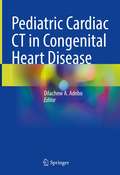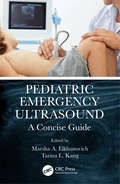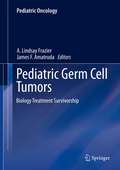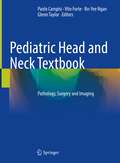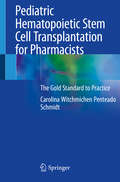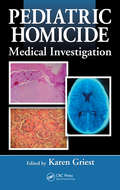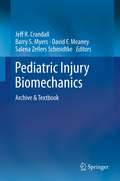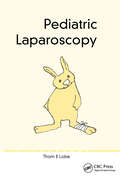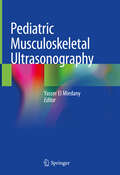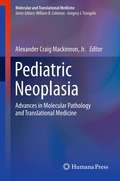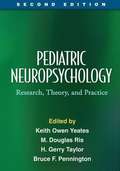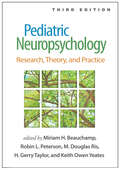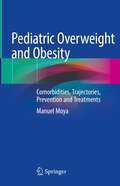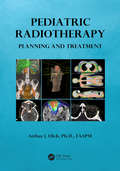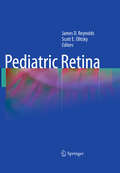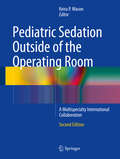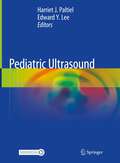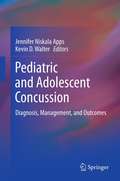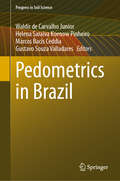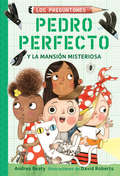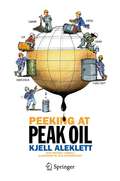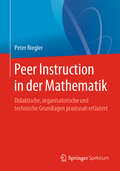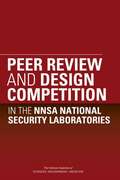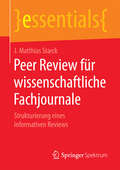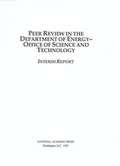- Table View
- List View
Pediatric Cardiac CT in Congenital Heart Disease
by Dilachew A. AdeboThis book serves as a comprehensive guide to pediatric cardiac computed tomography (CT), particularly for patients with congenital heart disease. Congenital heart disease (CHD) is the leading cause of congenital abnormalities (8/1000 of live births). Over the past two decades, the diagnostic medical approach has significantly changed with a considerable increase in the number of CT studies in pediatric patients. Preoperative surgical or interventional planning for children with CHD remains crucial and challenging, but despite this and the advancement in the development of new CT techniques and radiation dose reduction methods, there are limited books addressing pediatric cardiac CT.This work fills that gap by offering a complete look at the techniques and clinical utilization for pediatric cardiac CT with liberal use of images. The text begins with overarching themes of pediatric cardiac CT, like its advantages and techniques, and moves into covering different areas of the heart and possible presentations, like atrioventricular connections and cardiac tumors. Each chapter begins with a short introduction section followed by preoperative and postoperative cardiac CT imaging, management approach, and short-term and long-term outcomes. This book also describes the novel technologies being used for three-dimensional modelling and three-dimensional printing in the surgical preparation of patients with complex congenital heart disease. This book is the first to address pediatric cardiac CT image fusion to fluoroscopy to guide cardiac catheterization in patients with complex congenital heart disease. Radiation dose reduction during cardiac catheterization is also an important part of diagnostic and interventional cardiac catheterization that is covered in detail. The book concludes with an overarching look of the role cardiac CT plays in the pre- and post-operative evaluation of congenital heart disease in children.This book is an ideal guide for pediatric radiologists, pediatric cardiologists, pediatric cardiothoracic surgeons, related trainees, and any physician interested in advanced cardiac imaging.
Pediatric Emergency Ultrasound: A Concise Guide
by Marsha A. Elkhunovich Tarina L. Kang Courtney Brennan Kathryn Pade Rashida Campwala Jessica Rankin Kristin BeronaThis concise, portable manual provides practitioners and future practitioners with a basic guide to pediatric emergency ultrasound, enabling them to learn the fundamentals of bedside ultrasound and use these to refresh their skills prior to, or when, performing it on a patient.
Pediatric Germ Cell Tumors
by A. Lindsay Frazier James F. AmatrudaGerm cell tumors are relatively rare compared with other malignancies, and compilations of knowledge that encompass the entire spectrum of the disease are lacking. This textbook, written by the foremost authorities in the field, rectifies the situation by discussing in depth a broad range of topics, including biology, epidemiology, pathology, treatment, and late effects. Bearing in mind that germ cell tumors are most prevalent in the adolescent and young adult age group, causes of disease and treatment approaches in pediatric and adult patients are compared and contrasted. By spanning the entire life course, from prenatal origins of disease through to treatment in adults and late effects of treatment, the editors have produced a book that will be of interest to both pediatric and adult oncologists.
Pediatric Head and Neck Textbook: Pathology, Surgery and Imaging
by Glenn Taylor Paolo Campisi Vito Forte Bo-Yee NganThis book focuses on Pediatric Head and Neck Surgical Diseases and Pediatric Surgical Pathology. The core objective is to provide the reader the essential background of various head and neck diseases that are common and/or unique to children by highlighting the key diagnostic, clinical, and pathologic features. It encompasses a comprehensive spectrum of pediatric head and neck diseases that are congenital or acquired. Many chapters describe the clinical and radiologic presentation, age-specific differential diagnosis, and diagnostic histopathologic features. The clinical and pathologic aspects of diseases that are unique to children and young adults that are amenable to surgical care are specifically emphasized. Pediatric Head and Neck Textbook: Pathology, Surgery and Imaging is aimed at trainees and specialists in Pediatrics, Otolaryngology – Head & Neck Surgery, General and Pediatric Surgery, Pediatric Radiology and Pediatric Pathology.
Pediatric Hematopoietic Stem Cell Transplantation for Pharmacists: The Gold Standard to Practice
by Carolina Witchmichen SchmidtThis unique book is the first on pediatric hematopoietic stem cell transplantation that is especially intended for pharmacists – in recognition of the fact that Pediatric Oncology Pharmacy is an area where more and more specific knowledge is required in daily practice, yet pharmacists who work in pediatric stem cell transplantation do not have a book addressing their specific needs. This pioneering book will likely become the new gold standard for practice, addressing subjects such as stem cells and their differentiation mechanisms; aspects of embryonic and non-embryonic stem cells; stem cell transplantation in pediatrics; stem cell sources and related technical choices; stem cell donors; scheduling transplantations; diseases and chemotherapy protocols that require stem cell transplantation; stem cell homing; engraftment and repopulation of stem cells in bone marrow; autologous stem cell transplantation in pediatrics; allogeneic stem cell transplantation in pediatrics; and indications for autologous and allogeneic pediatric stem cell transplantation. Further, it discusses pediatric graft-versus-host disease and the pharmacist; antibacterial and antifungal prophylaxis; detailed chemotherapy, conditioning and trials for pediatric stem cell transplantation; conditioning granulocyte colony-stimulating factor (G-CSF) in pediatric stem cell transplantation; analyzing prescriptions and programming a pediatric stem cell transplantation; handling chemotherapy and adjuvant drugs for pediatric stem cell transplantation; stem cell transplantation in children up to 1 year old; and clinical pharmacy in pediatric stem cell transplantation. An easy-to-read yet comprehensive guide covering a wide range of topics essential to daily practice, the book offers an invaluable asset for pediatric hemato/ oncology pharmacists, hematologist pharmacists, clinical pharmacists, pediatric pharmacists, pharmaceutical residents and researchers alike.
Pediatric Homicide: Medical Investigation
by Karen GriestPediatric homicide investigations are clouded by a number of factors, not the least of which is a lack of straightforward resources. The cause of death in infants and children is often subtle and difficult to establish. Designed for quick access, Pediatric Homicide: Medical Investigation provides an invaluable resource for medical examiners, police
Pediatric Injury Biomechanics
by Barry S. Myers Jeff R. Crandall Salena Zellers Schmidtke David F. MeaneyPediatric Injury Biomechanics: Archive and Textbook consolidates and describes the current state of the art in pediatric injury biomechanics research in the automotive crash environment. Written by the most respected scientists in the field, the objective of this ground-breaking project is to provide a comprehensive archive and analysis of pediatric injury biomechanics research; to be the go-to reference for the epidemiology of motor vehicle related childhood injury data, pediatric anthropometry, pediatric biomechanical properties, tissue tolerance, and computational models. This book provides essential information needed by researchers working in the field of pediatric injury including those involved in rulemaking activities, injury criteria development, child dummy development, and child injury interventions development. In addition to the text, a companion archive will include valuable information and tools to assist in the identification of gaps in research and future research directions.This living document will be regularly updated with current research and advancements in pediatric injury biomechanics.
Pediatric Laparoscopy
by Thom E LobeSince pediatric surgeons can and do perform nearly every major pediatric surgical procedure laparoscopically, and since many of the approaches have evolved some over the years—past the learning curve—into cost effective operations that rarely take extra time to perform, or in some cases save time, it is worthwhile reviewing our current practices. This book, then, serves as both an update of current practices and as a manual for how to approach the most common of the pediatric disorders using laparoscopic techniques. It covers the basics of anesthesia, instrumentation and ergonomics and then reviews many of the more commonly performed laparoscopic and thoracoscopic pediatric procedures, including a review of fetal work. While any book written about such a rapidly evolving technique may miss some of the very newest twists and modifications of technique, it is our hope that most of the contents will serve the readers as a reference for years to come as they care for children with common pediatric surgical problems.
Pediatric Musculoskeletal Ultrasonography
by Yasser El MiedanyThis book provides a comprehensive compilation of musculoskeletal ultrasonography (MSUS) fundamentals in pediatric rheumatology with emphasis on imaging techniques, normal anatomy, approaches towards standardization, and the spectrum of pathologic findings seen in the pediatric population. It examines the techniques and pitfalls of MSUS in pediatrics and compares sonoanatomy in pediatric patients versus adults. Chapters cover a range of anatomical sites, including shoulder and arm, elbow and forearm, wrists and hands, hip and thigh, knee and leg, and ankle and feet. The text also discusses the use of ultrasonography in juvenile inflammatory arthritic conditions and sports-related injuries. Finally, the book concludes with a summary of the recent advances in pediatric musculoskeletal ultrasonography. Featuring contributions from a large international group of leaders in the field, Pediatric Musculoskeletal Ultrasonography is an authoritative reference for pediatric and adult rheumatologists, sonographers, radiologists, physiotherapists, and orthopedic specialists.
Pediatric Neoplasia
by Alexander Craig Mackinnon JrPediatric Neoplasia: Advances in Molecular Pathology and Translational Medicine presents many of the major, relevant advances in molecular pathology that are occurring in the field of pediatric oncology and will serve as a useful overview for resident and attending physicians as well as scientists interested in understanding the molecular pathology of pediatric cancer in the context of clinical medicine. Chapters are based upon organ systems, and each is written by an expert or pair of experts in their field with subspecialty training and extensive clinical experience. Each chapter describes a variable number of tumors and includes an overview of the classification system and clinicopathological characteristics of each tumor. This is followed by a discussion of the molecular pathology relevant to a specific tumor, including specific molecular markers of the tumors, methods used for diagnosis or clinical management, clinical significance of the markers, and if appropriate, a description or discussion of current activities in translational research or issues that need to be addressed in the future. Pediatric Neoplasia: Advances in Molecular Pathology and Translational Medicine will be of great value to pathologists, oncologists, hematologists, internal medicine and pediatric specialists, as well as pharmaceutical professionals and translational and clinical researchers.
Pediatric Neuropsychology, Second Edition
by Keith Yeates M. RisThe most comprehensive, authoritative reference of its kind, this acclaimed work examines a wide range of acquired, congenital, and developmental brain disorders and their impact on children\u2019s neuropsychological functioning. Leading experts present state-of-the-art knowledge about how each condition affects the developing brain; the nature and severity of associated cognitive, behavioral, and psychosocial impairments; and effective approaches to clinical evaluation and treatment planning. New to This Edition Reflects significant scientific advances. An additional coeditor, Bruce F. Pennington. Chapters on math, reading, and language disabilities; attention-deficit/hyperactivity disorder; autism; and intellectual disabilities. Medical disorders not covered in prior edition acute disseminated encephalomyelitis and multiple sclerosis; tuberous sclerosis; childhood stroke; and fetal alcohol syndrome. A chapter on evidence-based neuropsychological interventions.
Pediatric Neuropsychology, Third Edition: Research, Theory, and Practice
by Miriam H. Beauchamp, Robin L. Peterson, M. Douglas Ris, H. Gerry Taylor and Keith Owen YeatesRecognized as the definitive reference and text on the relationship between brain health and behavior in children and adolescents, this volume is now in a third edition with 75% new material, including major updates throughout and numerous new chapters. Leading experts provide a neuropsychological perspective on medical, neurological, genetic, and developmental disorders that are frequently seen in clinical practice. The volume examines the impact of each condition on the developing brain; explores associated cognitive, behavioral, and psychosocial impairments; and shows how the science translates into achieving better outcomes for children. New to This Edition *Reflects 12 years of significant research advances and the expanding role of pediatric neuropsychologists; increased attention to evidence-based intervention throughout. *Chapters on additional medical and neurodevelopmental conditions: pediatric stroke, congenital heart disease, type 1 diabetes, and movement disorders. *Section on genetic disorders: fragile X, Williams syndrome, 22q11.2 deletion syndrome, and Down syndrome. *Section on emergent and controversial conditions: nonverbal learning disabilities, dysexecutive syndrome, pediatric acute-onset neuropsychiatric syndrome, and sluggish cognitive tempo.
Pediatric Overweight and Obesity: Comorbidities, Trajectories, Prevention and Treatments
by Manuel MoyaThis book focuses on the worldwide frequent and growing problem with its projective trajectory that encompasses pediatric overweight and obesity. Through the ten chapters it offers in the first four a comprehensive state of art of the bases of pediatric obesity in order to support the following ones with new and proved clinical issues, as recent complementary features on anthropometry and food intake and new safe treatments. This books discusses comorbidities, trajectories, prevention, extended periods and treatment. For effective prevention, clues are given to routinely screen all comorbidities that are already present in overweight or obese children but frequently overlooked.This volume will be of benefit to pediatricians, endocrinologists and all healthcare providers interested in the care of children and adolescents.
Pediatric Radiotherapy Planning and Treatment
by Arthur J. OlchBy becoming knowledgeable about optimal treatment methods designed specifically for childhood cancers, members of a radiotherapy team can help improve both pediatric cancer survival statistics and patients' quality of life. Pediatric Radiotherapy Planning and Treatment is the first single, focused resource available for health care providers to acc
Pediatric Retina
by James D. Reynolds Scott E. OlitskyPediatric retinal diseases are not simply retinal diseases that occur in children; rather, they are unique disorders that often are not found in adults. This textbook of the pediatric retina offers in-depth guidance on congenital and acquired diseases of the retina in the pediatric population. It is organized according to disease onset and timing, as well as anatomy. All chapters are written by leading authorities in the field from both the pediatric and the retinal perspective. A multidisciplinary approach to the topic is adopted, and critical information is included on disease classification and diagnosis, pathophysiology, genetics, complications, and prognosis. Pediatric Retina will be a useful source of information for pediatric ophthalmologists, retina specialists, and other eye care providers who care for children.
Pediatric Sedation Outside of the Operating Room
by Keira P. MasonThis comprehensive guide provides tips and instruction for the entire range of specialists that utilize pediatric sedation. Each specialty receives tailored coverage that focuses on its unique patient population, challenges, potential solutions, and sedation techniques. Each chapter is written by a leading specialist in the field. A comprehensive spectrum of pediatric sedation will be covered, which will be of interest to oncologists, pediatricians, hospitalists, intensivists, radiologists, emergency medicine specialists, anesthesiologists, nurses, dentists, and gastroenterologists. Background chapters cover pharmacology as well as pediatric anatomy, with special focus on the airway and respiratory mechanics. The future of pediatric sedation is also reviewed as well as the cutting-edge research that is being done in the field.
Pediatric Ultrasound
by Edward Y. Lee Harriet J. PaltielThis essential book is a unique, authoritative and clinically oriented text on pediatric ultrasound. It provides up-to-date information addressing all aspects of congenital and acquired disorders in children encountered in clinical practice. The easy-to-navigate text is divided into 20 chapters. Each chapter is organized to cover the latest ultrasound techniques, normal development and anatomy, anatomic variants, key clinical presentations, characteristic ultrasound imaging findings, differential diagnoses and relevant pitfalls. With more than 2400 images, examples of new technological developments such as contrast-enhanced ultrasound and elastography are included. Written by internationally known pediatric radiology experts and editorial team lead by acclaimed authors, Harriet J. Paltiel, MDCM and Edward Y. Lee, MD, MPH, this reference is a practical and ideal guide for radiologists, radiology trainees, ultrasound technologists as well as clinicians in other specialties with an interest in pediatric ultrasound.
Pediatric and Adolescent Concussion
by Jennifer Niskala Apps Kevin D. WalterBetween the growing numbers of children and adolescents playing sports and the increased attention to head injuries by the larger sports community and the general public, pediatric concussions are emerging as a major concern. And as practitioners are seeing more young clients with head injuries, questions arise about age-appropriate assessment, diagnosis, treatment, and return to activity. Pediatric and Adolescent Concussion: Diagnosis, Management, and Outcomes offers evidence-based guidelines where few previously existed. This comprehensive volume clearly explains the effects of traumatic injury on the developing brain in sports- and non-sports-related contexts, and establishes a framework for immediate and long-term management, especially the crucial first 24 hours. Chapters provide a basic grounding in its subject with a history of concussion as a medical entity and a review of definitional and classification issues, take the reader through the steps of a neuropsychological evaluation, pinpoint post-injury issues, and offer strategies for the prevention of further or future injury. Pediatric and Adolescent Concussion: Diagnosis, Management, and Outcomes serves as both educational resource and practical framework for a wide array of professionals, including neuropsychologists, sports medicine physicians, child psychologists and psychiatrists, pediatric and family physicians, athletic trainers, social workers, and educators.
Pedometrics in Brazil (Progress in Soil Science)
by Marcos Bacis Ceddia Waldir de Carvalho Junior Helena Saraiva Koenow Pinheiro Gustavo Souza ValladaresIn a world expected to reach a population of almost 10 billion inhabitants by 2050 and facing rapid global warming, it is essential to develop studies to better characterize and preserve the existing environmental heritage. Among these assets, soil stands out, which is fundamental for the balance of life on the planet (air quality and composition, temperature regulation, carbon and nutrient cycling, water cycling and quality, natural "waste" (decomposition) treatment and recycling, and habitat for most living things and their food). Due its importance, Soil information is increasing recently in order to attend human demands for land use management and capability, reduce erosion risks and soil security, for example. Particularly in Brazil, advances in soil science are now required to attend the new national systematic soil survey that have as a goal soil sustainability and security. Gathering machine learning tools, pedometrics and pedological concepts is a way to achieve these demands regarding soil data and related products. This book summarizes remarkable insights from the II Pedometrics Brazil Conference providing cutting-edge information to researchers, students and professionals working with soils in tropical countries such as Brazil.
Pedro Perfecto y la mansión misteriosa
by Andrea BeatyPedro Perfecto es un arquitecto en su esencia: cuando no está haciendo casas con comida, su cabeza está en las nubes, soñando con el diseño. Así que queda totalmente impresionado cuando la tía Bernice de Ada Twist hereda una vieja casa del magnate de los helados Herbert Sherbert que está llena de innumerables habitaciones de todos sus períodos arquitectónicos favoritos. Pero algo no anda bien. . . Todo el mundo dice que la casa está embrujada, y parece que varias antigüedades con un valor incalculable, que supuestamente ayudarían a la tía Bernice a pagar el mantenimiento de la casa, han desaparecido. Si no pueden encontrar esas antigüedades, la tía Bernice podría perder la casa para siempre. ¡Se necesitarán todos los conocimientos de arquitectura de Pedro y la ayuda de los otros interrogadores, Rosie Revere, Ada Twist y Sofia Valdez, para resolver el misterio y encontrar el tesoro!
Peeking at Peak Oil
by Michael Lardelli Olle Qvennerstedt Kjell AleklettThe term "Peak Oil" was born in January 2001 when Colin Campbell formed the Association for the Study of Peak Oil & Gas (ASPO). Now, Peak Oil is used thousands of times a day by journalists, politicians, industry leaders, economists, scientists and countless others around the globe. Peak Oil is not the end of oil but it tells us the end is in sight. Anyone interested in food production, economic growth, climate change or global security needs to understand this new reality. In Peeking at Peak Oil Professor Kjell Aleklett, President of ASPO International and head of the world's leading research group on Peak Oil, describes the decade-long journey of Peak Oil from extremist fringe theory to today's accepted fact: Global oil production is entering terminal decline. He explains everything you need to know about Peak Oil and its world-changing consequences from an insider's perspective. In simple steps, Kjell tells us how oil is formed, discovered and produced. He uses science to reveal the errors and deceit of national and international oil authorities, companies and governments too terrified to admit the truth. He describes his personal involvement in the intrigues of the past decade. What happens when a handful of giant oil fields containing two thirds of our planet's oil become depleted? Will major oil consumers such as the EU and US face rationing within a decade? Will oil producing nations conserve their own oil when they realize that no one can export oil to them in the future? Does Peak Oil mean Peak Economic Growth? If you want to know the real story about energy today and what the future has in store, then you need to be "Peeking at Peak Oil".
Peer Instruction in der Mathematik: Didaktische, organisatorische und technische Grundlagen praxisnah erläutert
by Peter RieglerSie möchten Ihre Lehrveranstaltungen aktivierender und wirksamer gestalten? Sie möchten die Verständnisschwierigkeiten Ihrer Studierenden besser erkennen und verstehen? Sie möchten die studentische Beteiligung steigern, zum Nachdenken und Diskutieren anregen? Lernen Sie das Potenzial von Clickerfragen für die akademische Lehre kennen – damit es bei Ihren Studierenden klick macht! In diesem Buch werden die Grundlagen der interaktiv-dialogischen Lehrmethode praxisnah erläutert. Dabei werden auch häufige Fragen zu didaktischen, organisatorischen und technischen Aspekten beantwortet, etwa:Was ist die Grundidee von Peer Instruction?Wie wirksam ist Peer Instruction? Wie überzeuge ich meine Studierenden davon?Welche technischen Voraussetzungen gibt es?Wie stelle ich gute Clickerfragen?Was sollte ich sonst noch beachten?
Peer Review and Design Competition in the NNSA National Security Laboratories
by Committee on Peer Review Design Competition Related to Nuclear WeaponsThe National Nuclear Security Administration (NNSA) is responsible for providing and maintaining the capabilities necessary to sustain a safe, secure, and reliable nuclear weapons stockpile for the nation and its allies. Major responsibility for meeting the NNSA missions falls to the three NNSA laboratories: Los Alamos National Laboratory (LANL), Lawrence Livermore National Laboratory (LLNL), and Sandia National Laboratories (SNL). The NNSA National Security Laboratories contribute to that goal by maintaining the skills and capabilities necessary for stewardship of a reliable nuclear stockpile and also by maintaining a high level of technical credibility, which is a component of the nuclear deterrent. Since 1992 it has been U. S. policy not to conduct explosion tests of nuclear weapons. The resulting technical challenges have been substantial. Whereas a nuclear test was in some sense the ultimate "peer review" of the performance of a particular NEP design, the cessation of nuclear testing necessitated a much greater reliance on both intralab and interlab expert peer review to identify potential problems with weapon designs and define the solution space. This report assesses the quality and effectiveness of peer review of designs, development plans, engineering and scientific activities, and priorities related to both nuclear and non-nuclear aspects of nuclear weapons, as well as incentives for effective peer review. It also explores how the evolving mission of the NNSA laboratories might impact peer review processes at the laboratories that relate to nuclear weapons.
Peer Review für wissenschaftliche Fachjournale: Strukturierung eines informativen Reviews (essentials)
by J. Matthias StarckJ. Matthias Starck führt den Leser in diesem essential durch alle Schritte des Schreibens eines Peer Reviews für eine wissenschaftliche Zeitschrift. Es baut auf einer prägnanten Analyse auf, wie Wissenschaft funktioniert, wie sie kommuniziert und wie sie veröffentlicht wird. Der Autor diskutiert verschiedene Peer-Review-Verfahren und deren mögliche Alternativen, ethische Leitlinien ebenso wie die ,dunklen Seitenʻ des wissenschaftlichen Publizierens. Damit hilft dieses essential dem Leser, im bestehenden System erfolgreich zu arbeiten sowie zu seiner weiteren Entwicklung und Verbesserung beizutragen.
Peer Review in the Department of Energy-Office of Science and Technology: Interim Report
by Committee on the Department of Energy-Office of Science Technology's Peer Review ProgramA report on Peer Review in the Department of Energy-Office of Science and Technology
